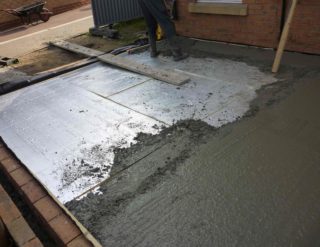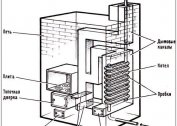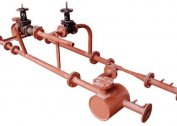During the construction of a house or repair, insulation is often used under the screed. It can significantly reduce the percentage of heat loss during the heating season. Different materials may be used for this technology. It all depends on the features of the future flooring.
Requirements for insulation
Before applying this or that variant of thermal insulation, it is necessary to take into account some operational characteristics, as well as the permissibility of using the material for the screed device.
- Any type of insulation at the time of installation and during the life of the product must retain the form specified by the manufacturer.
- The material should be as environmentally friendly and safe. After fixing under the screed, it should not emit unpleasant odors.
- Good vapor permeability will provide moisture to the outside, so the material will not get wet.
- The dense structure will make it possible to create a sufficient level of thermal and noise insulation.
Each of the materials has individual requirements for installation, differs in its features, which are acceptable for use in a particular case.
Materials for insulation screeds
In order to properly organize the insulation, it is necessary to choose the appropriate option for raw materials.
Styrofoam and Styrofoam
You can create the optimal level of thermal insulation at home using polystyrene foam or expanded polystyrene. These materials have a relatively elastic structure. They are laid with plates, having previously selected the desired thickness. This raw material contains 96% of air, so it is considered natural. Thanks to this material, it is possible to minimize the heat transfer under a concrete screed in the house and in the apartment. The main advantage of the canvas is its versatility.
Expanded clay
 Expanded clay is a loose heater for a floor under a screed of a large fraction. Its basis is foamed burnt clay. Material is poured into specially prepared niches and is evenly distributed over the surface. Initially, only this raw material was used to warm the floor screed. The main condition for the use of expanded clay is the installation of waterproofing from above, since when filling the screed, all thermal insulation turns into expanded clay.
Expanded clay is a loose heater for a floor under a screed of a large fraction. Its basis is foamed burnt clay. Material is poured into specially prepared niches and is evenly distributed over the surface. Initially, only this raw material was used to warm the floor screed. The main condition for the use of expanded clay is the installation of waterproofing from above, since when filling the screed, all thermal insulation turns into expanded clay.
Foil insulation for concrete screed
Foiled canvas consists of two layers. The first plays the role of a base and substrate, the second is a reflector. The basis of such insulation is usually foamed polyethylene under the screed or polystyrene. It is white or blue. Stacked under concrete, has good reflective properties. The product with foil retains heat well, and also prevents the penetration of moisture.
Mineral wool for concrete

This insulation under the screed is considered inconvenient for installation on floor concrete floors. It is quite difficult to properly lay and isolate from moisture. Raw materials require special surface preparation, in particular, laying a vapor barrier film. A special waterproofing material is also laid on top of the insulation before pouring concrete. If this is not done, the internal equipment of the floor will not fulfill its function.
Polystyrene plates
They are a kind of foam. You can fix the insulation on the floor under the screed using special glue or cement mortar.It is also allowed to perform a floating insulation pad. This material is characterized by good resistance to deformation, excellent moisture resistance.
Polystyrene boards can hold up to 93% of the heat in the room. The option is acceptable for warming a private house or apartment.
Waterproofing roughing screed
Draft screed is found mainly in their own homes. It is a concrete pouring directly to the ground. Also, this design is optimal for arranging a yard or garage building.
After the screed pouring step, waterproofing should be performed to completely eliminate the formation of condensate from the soil. It is mounted using special roll insulators - usually a bitumen sheet or membrane films.
The insulating layer must be wound on adjacent walls by about 10-15 cm. To remove the excess layer, you need to perform surface sanding.
If it is not possible to lay a hydroisol in front of the concrete screed, first fill in a small layer of the monolith. After solidification, a layer of bitumen material or roofing material is applied.
Screed floor insulation options
There are several options for installing insulation under a concrete screed. Each of them is applied in individual cases.
- Floor slab. In such designs, it is advisable to use a standard film, which is laid in two layers. This makes it possible to achieve an insulation thickness of 300 microns. Weldable bitumen is also used. However, it is not very practical, as it retains all the irregularities of the concrete screed.
- In the basement level. Under the slab there is usually a basement, garage or cellar. In this case, thermal insulation is performed from materials that are not subject to moisture absorption (styrofoam, polystyrene, and others).
- Between the floors. So that during the heating season in the apartments there is no loss of thermal energy, thermal insulation is performed between floors in concrete screed layers. For such structures, expanded clay, basalt wool or expanded polystyrene are considered the best options.
Liquid insulation in apartment buildings is practically not used as thermal insulation. It is rational to apply in partitions where pipelines pass, provided that there is another insulation.
Installation tips
To properly lay the insulation on the floor on the screed, you need to follow some simple recommendations. Every nuance can be decisive in the installation process.
- When performing the screed, a gap between the wall and the floor should be 1-3 cm.
- Without waterproofing, thermal insulation for concrete screed is not done.
- It is important to follow the sequence of work when organizing thermal insulation.
- The floor cake must consist of at least five layers.
Upon completion of the installation of thermal insulation for concrete floor screed, professionals recommend additionally installing insulation reinforcement.







